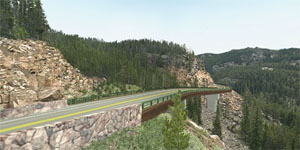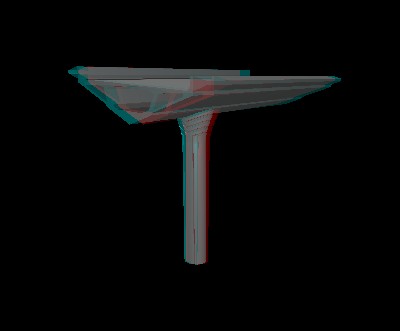Advanced Presentation Techniques
This section covers a few of the more innovative tools and techniques that will help the designer better present digital images. Most of these tools will be available to the designer or to someone within each of the FLHD offices.
Layering Elements
A very effective way of comparing before and after views, alternatives within the same view, or sequential changes within a view is to layer the successive views and show them one after the other. If the sequential images are inserted in the exact same location and with the same scaling on successive slides within Powerpoint, the presentation can be moved forward or backward between the matched views. All that the viewer sees is the difference between the slides, the before and after comparison is very obvious.

The above image is an animated GIF file, which can be generated in Image Ready- a web oriented tool by Adobe that is included with Photoshop CS. The GIF file can be set up to display separate layers in the image file for a certain period of time. The image sequence illustrates the effectiveness of the technique for comparing those particular elements that change in successive views.
This method of presenting sequential layered views can be done a couple of ways. Powerpoint is very effective, if the images are inserted and resized in exactly the same way. The Image Display utility (in Presenting Rendered Images) will work well if the images are saved with sequential numbering in the file names: image001, image002....
Interactive 2D Applications
Powerpoint
Powerpoint is one of the best tools to quickly put together presentations. It can incorporate text with the most common files types of digital media for images, video, audio, QTVR, and more. It allows the construction of slides which are presented sequentially, so information and processes can be presented in stages.
Director
Macromedia Director is a multimedia authoring tool which offers the ability to combine several different kinds of digital media, set up customized interactivity using an advanced scripting language, and deliver the resulting product for playback on standard Windows and Mac platforms. Director files can be saved as "Shockwave" files for use on the web, and third party software, known as "Xtras", can be purchased to extent Director's capabilities beyond its standard functions. While Director offers a wide variety of possibilities for media use and interactivity, it is a relatively expensive package, and there is a learning curve to be able to utilize its full potential.
Panoramic images (QTVR)
Panoramic images a much wider view of a given location than standard photographs, up to a full 360 image. Panoramic images can be printed for display purposes, but more commonly they are used in a digital format, such as QTVR, for playback with interactivity on a computer. There are two methods for acquiring panoramic images, 1) Using a special panoramic lens, and 2) Shooting several individual standard photos in sequence and using computer software to "stitch" them into a panorama.

Click the image for a sample QTVR image (630KB) pan the mouse left and right to change the view.
Panoramic lenses
Panoramic lenses offer the advantage of being able to shoot a 360 image with just one shot, which can be a tremendous time saver when many panoramas are to be acquired. The resolution of such images is usually low, however, and panoramic lenses can be expensive.
Shooting standard photos
There are several software packages available that will accept a sequence of digital images from standard cameras, stitch them into one panoramic photo, and create a digital panoramic movie which can be rotated in 360 degrees. This solution requires special software, but offers more flexibility in terms of camera and lens type, and offers higher a higher resolution output. Specialized tripods and panoramic heads are available to help with the acquisition of individual photos.
2D Animation and Compositing Tools
Compositing is the process of assembling multiple images to make a final image. Adobe After Effects and Discreet Combustion offer the ability to composite various still and video images into a combination of the two. Generally, advanced techniques such as the use of transparency data (known as 'alpha channels') are employed to creating moving images that seamlessly combine various source imagery. Compositing allows images and video to be panned and zoom, and is also used for creating transitions between different imagery.
Adobe After Effects
After Effects is a software package made by Adobe, the same company that makes Photoshop. In its most common usage, After Effects imports Photoshop files, with layers intact, and allows those layers to be animated over time. Animatable properties include position, scale, rotation, opacity, and photoshop plug-in effects. The newest version allows the importation and animation of z-space data from 3D modeling software. One of the most powerful uses of After Effects is the ability to create animations over live video, which can significantly add to the amount of information communicated. Probably one of the most commonly seen examples of After Effects compositions are on network news programs, who often use the compositions as transitions between stories, or to graphically illustrate key story points. In typical design visualization usage, After Effects is used to create 2D animations and motion graphics sequences.
Discreet Combustion
Combustion is a compositing tool that is used primarily for video compositing, and combustion compositions can be seen in the special effects of music videos, and even Hollywood movies (the opening animation sequence of the movie "Catch Me If You Can" is a product of combustion). In typical design visualization usage, combustion is used to create animation over live video, and advanced 3D effects.
Other Advanced Tools
Screen Capture
The entire desktop, or a single window can be captured and turned into a new image within Photoshop. The Printscreen is on the upper right of the keyboard. Press the button for the whole desktop, or Alt+Printscreen for the current window. In Photoshop create a new image (Ctrl+N, or FILE>NEW. The resolution Photoshop suggests will be the resolution of the screen capture. Press Enter to create the new file, then paste (Ctrl+V or EDIT>PASTE will insert the capture as a ne Layer.
There are some utilities available that will capture animation from the screen as well. Camtasia Studio from Techsmith allows the capture of anything that is playing back on the screen, and turns the captured information into an animation file. An interactive session in Microstation where the camera position was moved, and Levels turned on and off, could be turned into an AVI that could be played in Powerpoint.
Stereoscopic Images
There are a couple of methods for viewing stereo images on a computer. Microstation can save out Views in an anaglyph format (one cyan and one red tinted image) that can be viewed with inexpensive glasses. Using the Save Image utility and selecting the Stereo shading mode, will create a red/cyan divided image. The glasses are available from several web vendors, search on anaglyph glasses.

Anaglyph Stereo Glasses

Anaglyph Stereo View
There are other utilities for using specialized shutter glasses for viewing full color stereo images on a normal monitor, or for projecting stereo out of dual projectors.
